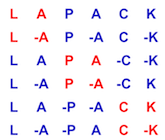 |
LAPACK 3.12.1
LAPACK: Linear Algebra PACKage
|
 |
LAPACK 3.12.1
LAPACK: Linear Algebra PACKage
|
| subroutine dsytf2 | ( | character | uplo, |
| integer | n, | ||
| double precision, dimension( lda, * ) | a, | ||
| integer | lda, | ||
| integer, dimension( * ) | ipiv, | ||
| integer | info ) |
DSYTF2 computes the factorization of a real symmetric indefinite matrix, using the diagonal pivoting method (unblocked algorithm).
Download DSYTF2 + dependencies [TGZ] [ZIP] [TXT]
!> !> DSYTF2 computes the factorization of a real symmetric matrix A using !> the Bunch-Kaufman diagonal pivoting method: !> !> A = U*D*U**T or A = L*D*L**T !> !> where U (or L) is a product of permutation and unit upper (lower) !> triangular matrices, U**T is the transpose of U, and D is symmetric and !> block diagonal with 1-by-1 and 2-by-2 diagonal blocks. !> !> This is the unblocked version of the algorithm, calling Level 2 BLAS. !>
| [in] | UPLO | !> UPLO is CHARACTER*1 !> Specifies whether the upper or lower triangular part of the !> symmetric matrix A is stored: !> = 'U': Upper triangular !> = 'L': Lower triangular !> |
| [in] | N | !> N is INTEGER !> The order of the matrix A. N >= 0. !> |
| [in,out] | A | !> A is DOUBLE PRECISION array, dimension (LDA,N) !> On entry, the symmetric matrix A. If UPLO = 'U', the leading !> n-by-n upper triangular part of A contains the upper !> triangular part of the matrix A, and the strictly lower !> triangular part of A is not referenced. If UPLO = 'L', the !> leading n-by-n lower triangular part of A contains the lower !> triangular part of the matrix A, and the strictly upper !> triangular part of A is not referenced. !> !> On exit, the block diagonal matrix D and the multipliers used !> to obtain the factor U or L (see below for further details). !> |
| [in] | LDA | !> LDA is INTEGER !> The leading dimension of the array A. LDA >= max(1,N). !> |
| [out] | IPIV | !> IPIV is INTEGER array, dimension (N) !> Details of the interchanges and the block structure of D. !> !> If UPLO = 'U': !> If IPIV(k) > 0, then rows and columns k and IPIV(k) were !> interchanged and D(k,k) is a 1-by-1 diagonal block. !> !> If IPIV(k) = IPIV(k-1) < 0, then rows and columns !> k-1 and -IPIV(k) were interchanged and D(k-1:k,k-1:k) !> is a 2-by-2 diagonal block. !> !> If UPLO = 'L': !> If IPIV(k) > 0, then rows and columns k and IPIV(k) were !> interchanged and D(k,k) is a 1-by-1 diagonal block. !> !> If IPIV(k) = IPIV(k+1) < 0, then rows and columns !> k+1 and -IPIV(k) were interchanged and D(k:k+1,k:k+1) !> is a 2-by-2 diagonal block. !> |
| [out] | INFO | !> INFO is INTEGER !> = 0: successful exit !> < 0: if INFO = -k, the k-th argument had an illegal value !> > 0: if INFO = k, D(k,k) is exactly zero. The factorization !> has been completed, but the block diagonal matrix D is !> exactly singular, and division by zero will occur if it !> is used to solve a system of equations. !> |
!> !> If UPLO = 'U', then A = U*D*U**T, where !> U = P(n)*U(n)* ... *P(k)U(k)* ..., !> i.e., U is a product of terms P(k)*U(k), where k decreases from n to !> 1 in steps of 1 or 2, and D is a block diagonal matrix with 1-by-1 !> and 2-by-2 diagonal blocks D(k). P(k) is a permutation matrix as !> defined by IPIV(k), and U(k) is a unit upper triangular matrix, such !> that if the diagonal block D(k) is of order s (s = 1 or 2), then !> !> ( I v 0 ) k-s !> U(k) = ( 0 I 0 ) s !> ( 0 0 I ) n-k !> k-s s n-k !> !> If s = 1, D(k) overwrites A(k,k), and v overwrites A(1:k-1,k). !> If s = 2, the upper triangle of D(k) overwrites A(k-1,k-1), A(k-1,k), !> and A(k,k), and v overwrites A(1:k-2,k-1:k). !> !> If UPLO = 'L', then A = L*D*L**T, where !> L = P(1)*L(1)* ... *P(k)*L(k)* ..., !> i.e., L is a product of terms P(k)*L(k), where k increases from 1 to !> n in steps of 1 or 2, and D is a block diagonal matrix with 1-by-1 !> and 2-by-2 diagonal blocks D(k). P(k) is a permutation matrix as !> defined by IPIV(k), and L(k) is a unit lower triangular matrix, such !> that if the diagonal block D(k) is of order s (s = 1 or 2), then !> !> ( I 0 0 ) k-1 !> L(k) = ( 0 I 0 ) s !> ( 0 v I ) n-k-s+1 !> k-1 s n-k-s+1 !> !> If s = 1, D(k) overwrites A(k,k), and v overwrites A(k+1:n,k). !> If s = 2, the lower triangle of D(k) overwrites A(k,k), A(k+1,k), !> and A(k+1,k+1), and v overwrites A(k+2:n,k:k+1). !>
!> !> 09-29-06 - patch from !> Bobby Cheng, MathWorks !> !> Replace l.204 and l.372 !> IF( MAX( ABSAKK, COLMAX ).EQ.ZERO ) THEN !> by !> IF( (MAX( ABSAKK, COLMAX ).EQ.ZERO) .OR. DISNAN(ABSAKK) ) THEN !> !> 01-01-96 - Based on modifications by !> J. Lewis, Boeing Computer Services Company !> A. Petitet, Computer Science Dept., Univ. of Tenn., Knoxville, USA !> 1-96 - Based on modifications by J. Lewis, Boeing Computer Services !> Company !>
Definition at line 191 of file dsytf2.f.